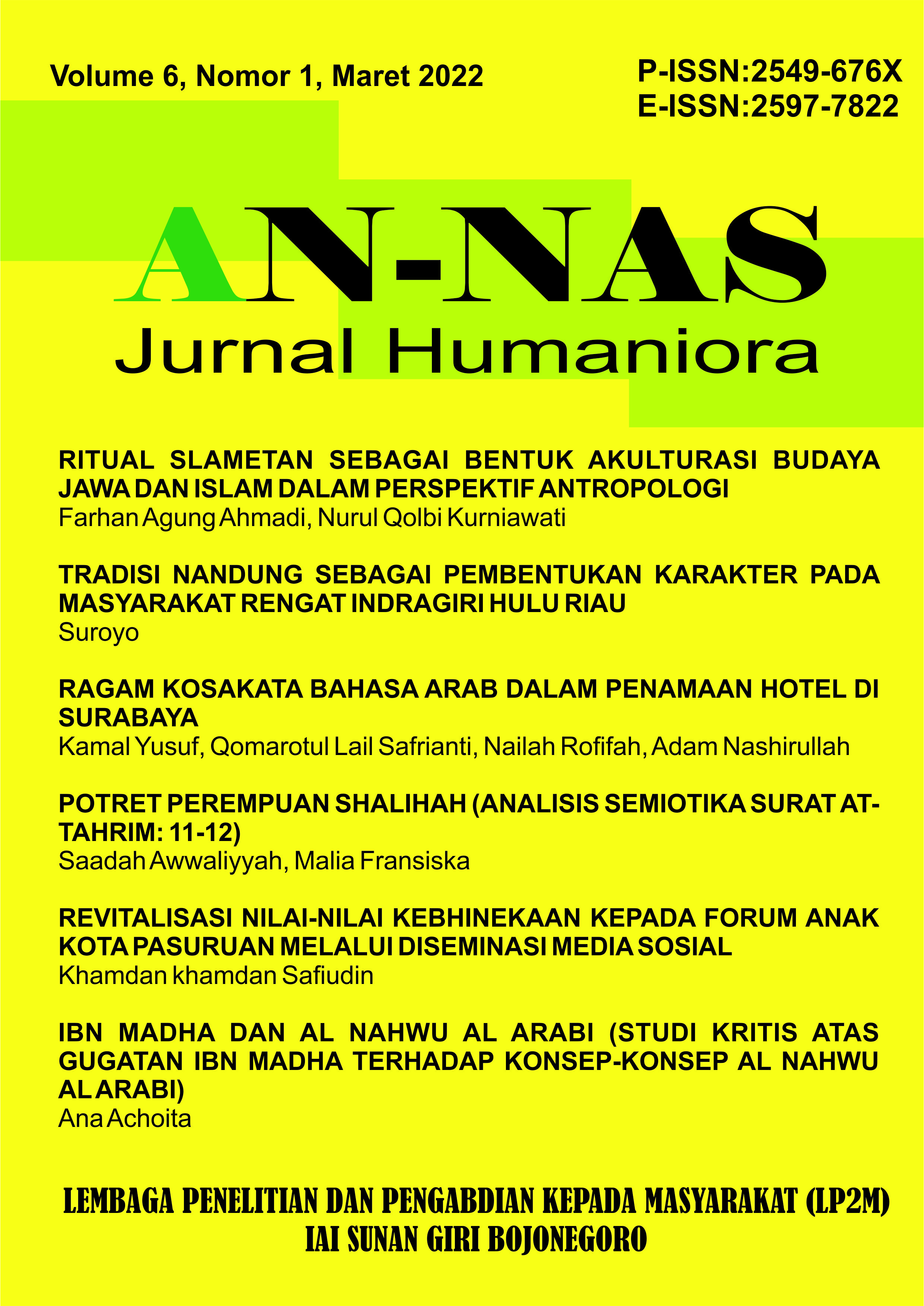TRADISI NANDUNG SEBAGAI PEMBENTUKAN KARAKTER PADA MASYARAKAT RENGAT INDRAGIRI HULU RIAU
 PDF Download: 70
PDF Download: 70
DOI:
https://doi.org/10.32665/annas.v6i1.2015Keywords:
Nandung, Character Building, Oral TraditionAbstract
Nandung tradition, which originated in Rengat, Indragiri Hulu Regency, Riau, is a type of local wisdom that demands purpose and function, as well as value in character development as capital in local culture. The culture that is passed down from generation to generation can be used to extract local knowledge (local knowledge) and local wisdom (local wisdom) in overcoming various obstacles in the formation of character formation. The method utilized is descriptive analysis with a qualitative approach, with the goal of describing the Nandung tradition in the Rengat community of Indragiri Hulu Riau as a character determinant. Because it contains the value of religious education, the value of moral education, and the value of social education, the Nandung tradition is full of values in moulding character, according to the conclusions of this studythe importance of social and cultural education, as well as psychological and religious principles The Nandung tradition's ideals of local wisdom are important in moulding the Rengat Indragiri Hulu community's character in conformity with Islamic law and Indragiri Hulu Malay culture.
References
Alit, Dewa Made, ‘Strategi Politik Majapahit Menaklukan Kerajaan Bali 1352- 1380 M’, Journal IKIP PGRI Bali, 07.1 (2019)
Alpiyah, Ni’mah, and Iis Purnengsih, ‘KARAKTER GAJAH MADA : SIMBOL KEJAYAAN MAJAPAHIT’, Visual Heritage: Jurnal Kreasi Seni Dan Budaya, 1.02 (2019), 147–53
Aruma, Dr. E. O., and Dr. Melvins Enwuvesi Hanachor, ‘Abraham Maslow’s Hierarchy of Needs and Assessment of Needs in Community Development’, International Journal of Development and Economic Sustainability, 5.7 (2017), 15–27
Desmet, Pieter, and Steven Fokkinga, ‘Beyond Maslow ’ s Pyramid : Introducing a Typology of Thirteen Fundamental Needs for Human-Centered Design’, Multimodel Technologies and Interaction, 4.38 (2020), 1–22
Isnaeni, Fiana, Maheda Ronie, Devi Hellystia, Universitas Gunadarma, and Jawa Barat, ‘Hierarchy of Needs Analysis of the Main Charackter of A Novel Entitled Flawed by Cecelia’, Journl of Language and Literature, 7.2 (2019), 146–54
Joomis, D. Martin and K., ‘Building Teachers: A Constructivist Approach to Introducing Education’, ed. by CA Belmont (Wadsworth, 2007), pp. 72–75
King-hill, Sophie, ‘Critical Analysis of Maslow ’ s Hierarchy of Need’, The STep Journal, 2.4 (2015), 54–57.
Kuntowijoyo.2003. Metodologi Sejarah: Edisi Kedua. Yogyakarta: PT. Tiara Wacana Yogya.
Mcleod, Saul, ‘Maslow ’ s Hierarchy of Needs’, Simply Psychology, 2018, pp. 1–16
Pangestika, Armadira Eno, Henry Susanto, and Myristica Imanita, ‘Penaklukan Bali Oleh Kerajaan Majapahit Tahun 1343 M’, 01, 2019
Peng, Song, ‘Maslow ’ s Hierarchy of Needs Theory Combined with Subjective Well-Being to Explore the Influencing Factors and Promotion Strategies’, Research & Development, 1.1 (2020), 19–24 <https://doi.org/10.11648/j.rd.20200101.12>
Soedarso, Nick, ‘Perancangan Buku Ilustrasi Perjalanan Mahapatih Gajah Mada’, Humaniora, 5.2 (2014), 561–70
Supriatin, Yeni Mulyani, ‘Perang Bubat, Representasi Sejarah Abad Ke-14 Dan Resepsi Sastranya’, Patanjala, 10.1 (2018), 51–56
Susilo, Agus, and Andriana Sofiarni, ‘Gajah Mada Sang Maha Patih Pemersatu Nusantara Di Bawah Majapahit Tahun 1336 M - 1359 M’, Jurnal Pendidikan Sejarah Dan Riset Sosial Humaniora (KAGANGA), 1.1 (2018), 62–71
Tanudirjo, Daud Aris, Insiparasi Majapahit, ed. by Daud Aris Tanudirjo (Klaten: PT. Intan Sejati, 2014)
UYSAL, H. Tescan, Sibel AYDEMIR, and Emine GENC, ‘MASLOW ’ S HIERARCHY OF NEEDS IN 21ST CENTURY : THE EXAMINATION OF’, Researches on Science and Art, November 2017, 2017, 1–18
Downloads
Published
Issue
Section
License

This work is licensed under a Creative Commons Attribution-ShareAlike 4.0 International License.
 PDF Download: 70
PDF Download: 70







